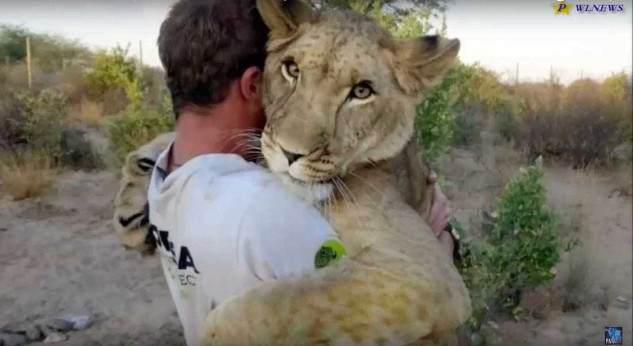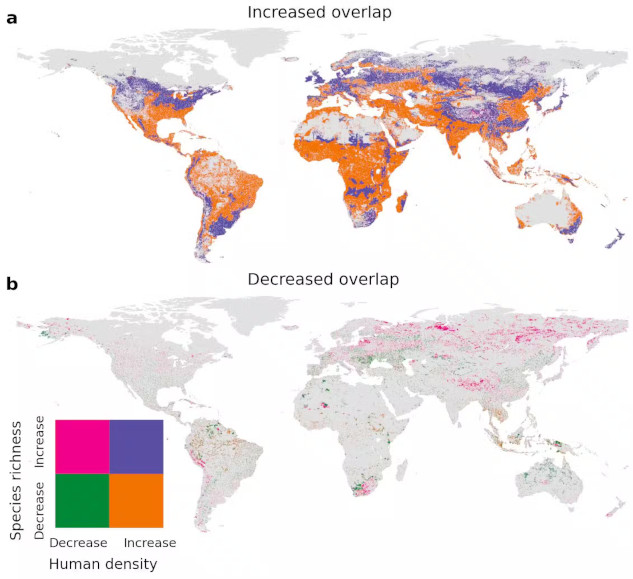
In This Article:
- How is human population growth affecting wildlife habitats worldwide?
- What does increasing human-wildlife overlap mean for global ecosystems?
- The role of climate change in shifting animal ranges and species richness.
- What are the potential benefits and conflicts of human-wildlife interactions?
- Exploring strategies for managing human-wildlife coexistence effectively.
- How can conservation planning guide a future with increasing human density?
- Insights into the need for local studies on human-wildlife interactions.
Human-Wildlife Overlap: A Growing Global Challenge
by Neil Carter and Deqiang Ma, University of Michigan
Human-wildlife overlap is projected to increase across more than half of all lands around the globe by 2070. The main driver of these changes is human population growth. This is the central finding of our newly published study in the journal Science Advances.
Our research suggests that as human population increases, humans and animals will share increasingly crowded landscapes. For example, as more people move into forests and agricultural regions, human-wildlife overlap will increase sharply. It also will increase in urban areas as people move to cities in search of jobs and opportunities.
Animals are also moving, mainly in response to climate change, which is shifting their ranges. Across most areas, species richness – the number of unique species present – will decrease as animals follow their preferred climates. But because human population growth is increasing, there still will be more human-wildlife overlap across most lands.
We also found areas where human-wildlife overlap will decrease as human populations shift, although these were much rarer than areas of increase.
 The top map shows areas with projected increasing human-wildlife overlap by 2070. In orange areas, human population density will increase, while species richness – the number of species present – will decrease; in purple areas, human population density and species richness will increase. The lower map shows where interactions will decrease. In green areas, human population density and species richness will decrease; in pink areas, human population density will decrease, while species richness will increase. Ma et al., 2024, CC BY-ND
The top map shows areas with projected increasing human-wildlife overlap by 2070. In orange areas, human population density will increase, while species richness – the number of species present – will decrease; in purple areas, human population density and species richness will increase. The lower map shows where interactions will decrease. In green areas, human population density and species richness will decrease; in pink areas, human population density will decrease, while species richness will increase. Ma et al., 2024, CC BY-ND
We found that Africa will have the largest proportion of land with increasing human-wildlife overlap (70.6%), followed by South America (66.5%). In contrast, Europe will have the largest proportion of land experiencing decreasing human-wildlife overlap (21.4%).
Why it matters
Around the world, humans and wildlife increasingly compete for limited space on land. This can lead to harmful outcomes, such as human-wildlife conflicts and the spread of diseases between humans and animals.
Interacting with wildlife, however, can also have benefits. For example, birds provide valuable pest control for some crops. And studies show that observing birds and animals in nature improves people’s mental health.
It is important to manage these interactions in ways that minimize negative impacts and maximize benefits. This is a key goal of the Global Biodiversity Framework that nations adopted in 2022 as a blueprint for conserving life on Earth and slowing the loss of wild species.
Our findings underscore the need to manage for coexistence between people and wildlife. Our research provides a broad understanding of where changes in human-wildlife overlap will occur in the future, including hot spots that will require more effective measures to improve human interactions with wildlife.
The Marin Livestock and Wildlife Protection Program in California helps ranchers pay for nonlethal methods to protect their herds from coyotes.
How we did our work
We developed a spatial index to measure human-wildlife overlap around the world. To calculate the degree of overlap region by region, we multiplied human population density by the number of species present in a given area. Our study included 22,374 land-dwelling species of amphibians, birds, mammals and reptiles.
By combining published datasets on most recent (2015) and future (2070) populations, species distributions and land types, we were able to investigate how human-wildlife overlap will change by 2070 and to identify the places where this overlap will increase most dramatically. We then investigated changes in species richness across each land type – cropland, grassland, urban and forest – with increasing human-wildlife overlap.
What’s next
Our research shows broadly how human-wildlife overlap will change, but researchers will need local studies to understand the consequences. Future research on shared lands should analyze factors including species abundance, species behavior and ecology, as well as types of interactions between people and wildlife.
Policymakers can use insights from our work to guide conservation planning in a more crowded future. For example, our projections can help identify locations for habitat corridors that enable wildlife to move between critical habitats. They also could help to identify areas that are relatively buffered from the effects of climate change over time and could serve as havens for at-risk species.
Our work can inform future conservation investments, such as rewilding areas where human population density is decreasing, or preserving and enhancing wildlife habitats in places that are becoming more urbanized.
Finally, our study shows the importance of engaging local communities in wildlife conservation. In our view, using many conservation strategies and taking human needs into account will be the most effective way to ensure sustainable coexistence.
Neil Carter, Associate Professor of Wildlife Conservation, University of Michigan et Deqiang Ma, Postdoctoral Researcher in Environment and Sustainability, University of Michigan
Article Recap:
Human-wildlife overlap is set to increase globally by 2070, driven primarily by human population growth. As humans encroach upon forests, farmlands, and urban areas, wildlife habitats face significant pressure. This article delves into the implications for ecosystems, highlighting the importance of conservation efforts and strategies for coexistence. Understanding the changes in species richness and human densities is crucial to managing these interactions sustainably.
This article is republished from The Conversation under a Creative Commons license. Read the original article.
Books on The Environment from Amazon's Best Sellers list
"Silent Spring"
by Rachel Carson
This classic book is a landmark in the history of environmentalism, drawing attention to the harmful effects of pesticides and their impact on the natural world. Carson's work helped to inspire the modern environmental movement and remains relevant today, as we continue to grapple with the challenges of environmental health.
Click for more info or to order
"The Uninhabitable Earth: Life After Warming"
by David Wallace-Wells
In this book, David Wallace-Wells offers a stark warning about the devastating effects of climate change and the urgent need to address this global crisis. The book draws on scientific research and real-world examples to provide a sobering look at the future we face if we fail to take action.
Click for more info or to order
"The Hidden Life of Trees: What They Feel, How They Communicate?Discoveries from A Secret World"
by Peter Wohlleben
In this book, Peter Wohlleben explores the fascinating world of trees and their role in the ecosystem. The book draws on scientific research and Wohlleben's own experiences as a forester to offer insights into the complex ways that trees interact with one another and the natural world.
Click for more info or to order
"Our House Is on Fire: Scenes of a Family and a Planet in Crisis"
by Greta Thunberg, Svante Thunberg, and Malena Ernman
In this book, climate activist Greta Thunberg and her family offer a personal account of their journey to raise awareness about the urgent need to address climate change. The book provides a powerful and moving account of the challenges we face and the need for action.
Click for more info or to order
"The Sixth Extinction: An Unnatural History"
by Elizabeth Kolbert
In this book, Elizabeth Kolbert explores the ongoing mass extinction of species caused by human activity, drawing on scientific research and real-world examples to provide a sobering look at the impact of human activity on the natural world. The book offers a compelling call to action to protect the diversity of life on Earth.

























